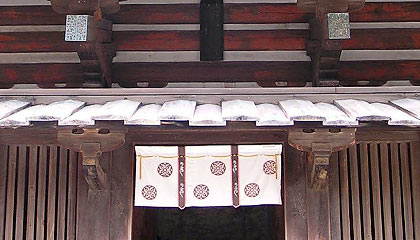|
||
 |
||
2@Shingle, thatched or cedar bark roofs found on tea ceremony houses *chashitsu º. The most common type is called shin ^. It has a lath base and a backing of bamboo battens about 2.4cm in diameter. These battens extend slightly beyond the edge of the barge course and are tied together by furring strips from below. Whole bamboo, Shakuhachidake Úª|, are sandwiched between the supporting bamboo. On top of these are boards, 39cm wide and 36cm thick, that follow the incline of the roof and are tied to the bamboo. At Fushin'an sRÁ in Kyoto, the roofing of this type was called hisashiyane ù®ª. Gyou s, is a semi-formal roofing method made with long bamboos arranged parallel to the rafters, but have no supporting battens osae-ita ¦Â. The method called sou , means simple or informal roofing without the long supporting bamboos. A simple covering of this type can be used only on a narrow roof. See *shin-gyou-sou ^s.

1)@Houryuuji Gojuu-no-tou @²Üd (Nara)
@
(C)2001 Japanese Architecture and Art Net Users System.@No reproduction or republication without written permission.
fÚÌeLXgEÊ^ECXgÈÇASÄÌRec̳f¡»E]ÚðֶܷB

